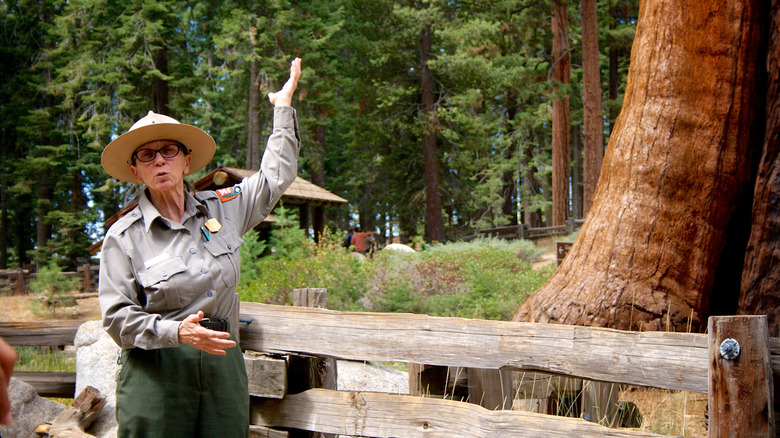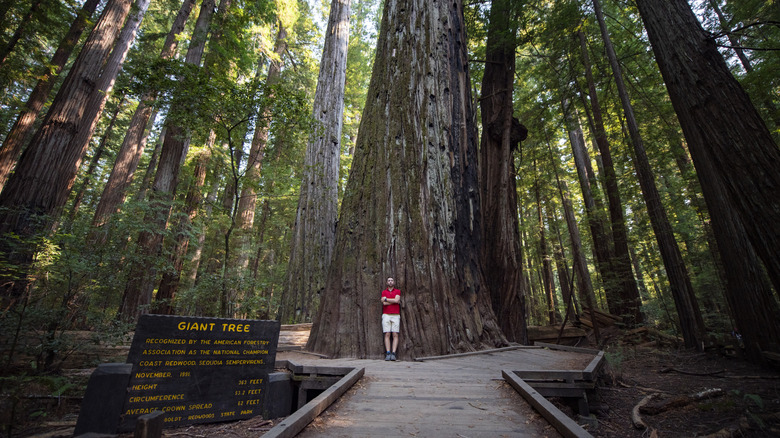Park Rangers Use This Communication Strategy To Protect National Parks (And You Can, Too)
A hiker pauses on a trail, keen to take a photograph of a bear they glimpsed in the nearby treeline. They take a few steps into the wildflower meadow for a better view, not realizing the damage those footsteps are causing. Just like the other 330 million-odd visitors who pass through America's most beautiful state and national parks each year, they've come to enjoy the trails and marvel at the unique sights at each one. But with this many people, these places need careful protection if future parkgoers are to enjoy the same sights and experiences.
While most don't plan to cause harm, misinformed or inexperienced visitors can unintentionally damage fragile ecosystems and put the parks at risk. This is why the Leave No Trace Seven Principles were created. By following park rangers' important advice, visitors can avoid making mistakes in national parks and help preserve these spaces for generations to come. The concept of Leave No Trace emerged in the 1960s and has been adopted by nature guides worldwide. It is used to educate visitors about how to minimize impact on wilderness areas while recreating and exploring.
The seven principles are simple, common-sense guidelines that should be top of mind when venturing into the great outdoors. They cover planning ahead and being prepared, traveling and camping on durable surfaces, disposing of waste properly, leaving what you find, minimizing campfire impacts, respecting wildlife, and being considerate of other visitors. Unfortunately, each year, park rangers come across visitors whose inappropriate behavior puts the wildlife or natural features at risk. To try and counter this, they use the proven framework known as the Authority of the Resource — a strategy you, too, can apply when you see someone ignoring the Leave No Trace principles.
Authority of the Resource, explained
Although it may be tempting for a park ranger to get angry when they see someone who is clearly breaking park rules, confrontation isn't always the best approach. Developed by Outward Bound educator Dr. George Wallace to help reduce damage to the parks and other wilderness areas, the Authority of the Resource approach focuses on trying to understand these people rather than angrily confronting them. It starts by building rapport with a person or persons with the aim of encouraging respect for nature, doing away with traditional authoritarian approaches of threats and consequences, which reduces the possibility of a heated exchange.
The proven framework consists of several stages, starting with a park ranger approaching a visitor, introducing themselves, and making polite conversation to build a rapport. Then, the ranger can state what they've seen the person do, avoiding using negative or accusatory language. While talking, the idea is to be shoulder to shoulder with the person rather than taking a more confrontational face-to-face stance. This shifts the focus to the resource — the aspect of nature in question — and an explanation of the consequences of a behavior on wildlife and the surrounding environment. The interaction ends with the park ranger suggesting an alternative behavior that would improve the situation. By making the resource itself the authority, this method turns a potential conflict into an opportunity for genuine understanding and lasting change. This is not something that just park rangers can do to promote respectful behavior in natural settings; it's something you can do, too.
How visitors can help protect national parks
As effective as this communication strategy has proven to be, park rangers can't be everywhere at once. This is where visitors can step in to make a positive difference. Picture walking on a carpet of soft needles in Sequoia National Park. As you're admiring the beauty of the centuries-old trees, you notice some other hikers carving their initials into the bark. This would be the moment to use the framework and explain how damage to the trees can cause disease and the consequences for the ecosystem if everyone did the same. Or imagine taking a drive out to Rocky Mountain National Park to spend the morning watching elk graze from a safe distance. You head to the nearby picnic area for a bite to eat, but when you get there, raccoons are hanging around because a group is throwing them scraps. Here, you could explain that wild animals risk losing their natural foraging skills when you feed them and may become aggressive if they associate people with an easy meal.
Neither of these situations calls for angry confrontations. Rather, the aim should be to teach people how their actions affect the natural world. As Wallace pointed out, most people don't intend to do harm but are merely misinformed or inexperienced. Once they understand the consequences of their actions, they can change how they behave and pass on the information to other visitors, helping to create a better experience for current and future visitors. For those who want to turn their knowledge of the Leave No Trace principles into action, instructor courses are available that teach people how to help conserve and protect the vast treasures that lie within our national parks.


